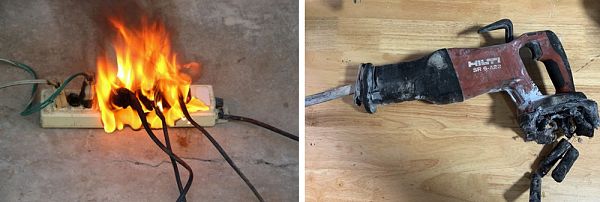What you need to know about
COVID-19 | Click here

What you need to know about
COVID-19 | Click here


Wednesday November 2, 2022 14:36
With the increased use of battery powered tools, many of which are now powered by higher voltage (up to 24 volts) Lithium-Ion [Li-Ion] batteries, there is the potential for these batteries to cause a fire, especially if they are not looked after. Damage to the tool and/or battery increases the risk. If stored together, a fire from one battery powered tool can spread rapidly to other battery powered tools or combustible material.
Fires from Li-Ion batteries are very difficult to successfully extinguish, and they can flare up again after they appear to have been extinguished. Normal fire extinguishers found on sites (Dry Powder, CO2, etc) are not good at extinguishing Li-Ion battery fires. The best way of extinguishing a battery fire, if possible, is to drop the battery or both the tool and the battery into a bucket of water.
Ways to reduce the risk of a battery powered tool fire include:
The use of electrical multi-plug boards has always been a hazard, not only as a trip hazard with cables across floors or underfoot at desks, but also as an electrical hazard due to overloading.
With the increasing use of electrical devices (computers, printers, charges for a range of electronic devices), multi-plug boards are often being used to provide power sources for these devices. This is common in both the workplace and the home environment. Also, the recent increase in people working from home, either full time or part time, has increased the potential risk for the home environment. The added load by using heaters with the cold weather we have been recently experiencing adds to the potential risk. Often these multi-plug boards are hidden away under desks, behind cabinets, etc and out of sight (and mind). This can cause unintentional damage to the multi-plug boards and/or plugs and leads.
This use of multi-plug boards can lead to a potential overload of the electrical circuits within the building as more power is drawn to satisfy demand, especially if multi-plug boards are linked together. In older premises this can also result in overheating of old wiring systems as the wires heat up due to the increased demand and, in some cases, melt the insulation leaving exposed bare electrical wires. Worn and damaged plugs and leads can cause sparking at the multi-plug boards. At a minimum all multi-plug boards must have a current limiting system or be on a circuit with a RCD.
Preferably no multi-plug boards should be used at all. Wall mounted power points (installed by a qualified electrician), along with RCD devices on the power circuits should be installed in sufficient numbers to prevent the use of multi-plug boards. Consideration should also be given to routing cables away from being trip hazards by hanging cables from ceilings or arranging desks so cable trays can be used to keep cables tidy and out of the way.
Ref: Industrial Safety News
If you have any concerns around this topic or other Health & Safety matters, your Securo Consultant is available to help, so please give them a call or alternatively, you can contact Securo head office on 0800 55 33 44.